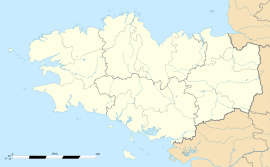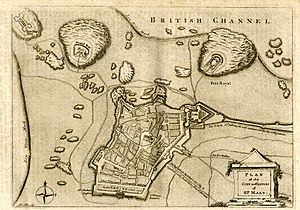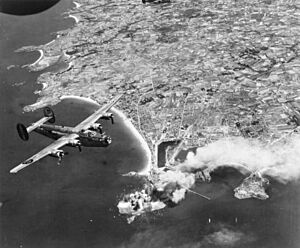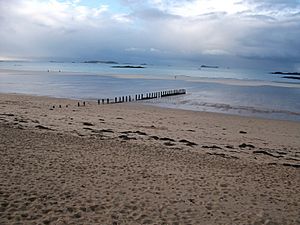Saint-Malo facts for kids
Quick facts for kids
Saint-Malo
|
|||
|---|---|---|---|
|
Subprefecture and commune
|
|||
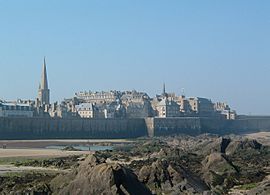
Walled city
|
|||
|
|||
| Country | France | ||
| Region | Brittany | ||
| Department | Ille-et-Vilaine | ||
| Arrondissement | Saint-Malo | ||
| Canton | Saint-Malo-1 and 2 | ||
| Intercommunality | CA Pays de Saint-Malo | ||
| Area
1
|
36.58 km2 (14.12 sq mi) | ||
| Population
(2021)
|
47,323 | ||
| • Density | 1,293.69/km2 (3,350.6/sq mi) | ||
| Time zone | UTC+01:00 (CET) | ||
| • Summer (DST) | UTC+02:00 (CEST) | ||
| INSEE/Postal code |
35288 /35400
|
||
| Elevation | 0–51 m (0–167 ft) (avg. 8 m or 26 ft) |
||
| 1 French Land Register data, which excludes lakes, ponds, glaciers > 1 km2 (0.386 sq mi or 247 acres) and river estuaries. | |||
Saint-Malo (pronounced "San Mah-low") is a historic port city in Brittany, France. It is famous for its old city walls.
This city on the English Channel coast was once known for its privateers. These were like legal pirates who brought a lot of wealth to the city.
Today, Saint-Malo is a popular place for tourists. It has a ferry terminal that connects to the Channel Islands (like Jersey and Guernsey) and cities in southern England like Portsmouth and Poole.
Saint-Malo is also the starting point for the famous Route du Rhum yacht race. This race happens every four years in November. Sailors race alone across the Atlantic Ocean to Pointe-à-Pitre in Guadeloupe.
Population: How Many People Live Here?
In 2017, about 46,097 people lived in Saint-Malo. However, this number can jump to 300,000 during the summer tourist season! If you include the areas around the city, the total population is about 133,000.
The city's population more than doubled in 1967. This happened when Saint-Malo joined with two other towns: Saint-Servan and Paramé.
People who live in Saint-Malo are called Malouins in French. The table below shows how the population has changed over many years.
| Historical population | |||||||||||||||||||||||||||||||||||||||||||||||||||||||||||||||||||||||||||||||||||||||||||||||||||||||||||||||||||
|---|---|---|---|---|---|---|---|---|---|---|---|---|---|---|---|---|---|---|---|---|---|---|---|---|---|---|---|---|---|---|---|---|---|---|---|---|---|---|---|---|---|---|---|---|---|---|---|---|---|---|---|---|---|---|---|---|---|---|---|---|---|---|---|---|---|---|---|---|---|---|---|---|---|---|---|---|---|---|---|---|---|---|---|---|---|---|---|---|---|---|---|---|---|---|---|---|---|---|---|---|---|---|---|---|---|---|---|---|---|---|---|---|---|---|---|
|
|
||||||||||||||||||||||||||||||||||||||||||||||||||||||||||||||||||||||||||||||||||||||||||||||||||||||||||||||||||
| Source: EHESS and INSEE (1968-2017) | |||||||||||||||||||||||||||||||||||||||||||||||||||||||||||||||||||||||||||||||||||||||||||||||||||||||||||||||||||
History: A Look Back in Time
Saint-Malo was first settled by the Gauls around 100 BC. The ancient Roman town here was called Reginca or Aletum. Later, in the 4th century AD, there was a strong fort in the Saint-Servan area. This fort protected the Rance river from sea invaders.
In the 5th and 6th centuries, many Celtic Britons came to this area. They were escaping problems across the Channel. The modern city of Saint-Malo started as a religious settlement. It was founded by Saint Aaron and Saint Brendan in the early 6th century. The city's name comes from Saint Malo or Maclou, who came from what is now Wales.
Saint-Malo has always been a bit independent. From 1590 to 1594, it even declared itself an independent republic! This is why the town's motto is: "Not French, not Breton, but Malouin."
Famous Privateers and Explorers
Saint-Malo became famous as the home of the corsairs. These were French privateers, who were like government-approved pirates. They would stop English ships in the Channel and demand money. They also brought wealth from far-off places.
One very famous person from Saint-Malo was Jacques Cartier. He sailed from here to the Saint Lawrence River in North America. He visited local villages that later became Quebec City and Montreal. Cartier was the first European to explore these areas. He learned the local word "Kanata," which meant "a group of houses." Because of this, Cartier is often called the discoverer of Canada.
The name Malouins (for people from Saint-Malo) also gave the Falkland Islands their Spanish name, Islas Malvinas. In 1764, French explorer Louis-Antoine de Bougainville named them Îles Malouines. He named them after the people of Saint-Malo, which was where his ships and settlers started their journey.
In 1758, the British tried to capture Saint-Malo in what was called the Raid on St Malo. They landed nearby and destroyed 30 privateer ships before leaving.
World War II: A City Rebuilt
During World War II, in August and September 1944, the historic walled city of Saint-Malo was almost completely destroyed. American forces heavily shelled and bombed it. The German commander, Colonel Andreas von Aulock, refused to surrender. He said he would fight "to the last man."
American soldiers attacked on August 5, 1944. German positions outside the city quickly fell. On August 13, the walled city was on fire. A short break was called so French civilians could escape. The last German holdouts surrendered on August 17. A nearby island, Cezembre, surrendered on September 2. The Americans took over ten thousand prisoners.
After the war, Saint-Malo was rebuilt. This took 12 years, from 1948 to 1960. In 1967, Saint-Malo merged with Saint-Servan and Paramé, becoming the larger city it is today.
In 1998, Saint-Malo hosted an important meeting between British and French leaders. This meeting led to a big agreement about European defense.
Climate: Weather in Saint-Malo
The Gulf of Saint-Malo has a mild, oceanic climate. The Gulf Stream ocean current helps keep temperatures from getting too extreme. The average temperature in January is 6.1°C (43°F), and in August it's 17.8°C (64°F). The average temperature for the whole year is 11.6°C (53°F).
| Climate data for Dinard Pleurtuit Saint-Malo | |||||||||||||
|---|---|---|---|---|---|---|---|---|---|---|---|---|---|
| Month | Jan | Feb | Mar | Apr | May | Jun | Jul | Aug | Sep | Oct | Nov | Dec | Year |
| Record high °C (°F) | 16.4 (61.5) |
18.7 (65.7) |
23.2 (73.8) |
26.9 (80.4) |
29.2 (84.6) |
33.1 (91.6) |
35.4 (95.7) |
39.4 (102.9) |
33.1 (91.6) |
28.9 (84.0) |
19.3 (66.7) |
17.6 (63.7) |
39.4 (102.9) |
| Mean daily maximum °C (°F) | 8.8 (47.8) |
9.3 (48.7) |
11.9 (53.4) |
13.7 (56.7) |
17.0 (62.6) |
19.8 (67.6) |
21.9 (71.4) |
22.0 (71.6) |
20.0 (68.0) |
16.3 (61.3) |
12.0 (53.6) |
9.2 (48.6) |
15.2 (59.4) |
| Mean daily minimum °C (°F) | 3.4 (38.1) |
3.1 (37.6) |
4.8 (40.6) |
5.9 (42.6) |
9.0 (48.2) |
11.5 (52.7) |
13.5 (56.3) |
13.6 (56.5) |
11.7 (53.1) |
9.4 (48.9) |
6.1 (43.0) |
3.7 (38.7) |
8.0 (46.4) |
| Record low °C (°F) | −13.7 (7.3) |
−11.7 (10.9) |
−6.2 (20.8) |
−2.8 (27.0) |
−0.2 (31.6) |
3.6 (38.5) |
6.7 (44.1) |
5.0 (41.0) |
2.3 (36.1) |
−4.2 (24.4) |
−5.9 (21.4) |
−9.6 (14.7) |
−13.7 (7.3) |
| Average precipitation mm (inches) | 67.0 (2.64) |
57.6 (2.27) |
53.5 (2.11) |
53.0 (2.09) |
63.6 (2.50) |
49.1 (1.93) |
49.7 (1.96) |
49.4 (1.94) |
62.2 (2.45) |
86.8 (3.42) |
86.8 (3.42) |
80.0 (3.15) |
758.7 (29.87) |
| Average precipitation days | 12.6 | 10.8 | 11.1 | 10.7 | 10.3 | 7.8 | 7.6 | 8.0 | 9.7 | 13.6 | 13.8 | 13.4 | 129.5 |
| Average snowy days | 1.7 | 2.5 | 1.4 | 0.6 | 0.0 | 0.0 | 0.0 | 0.0 | 0.0 | 0.0 | 0.3 | 1.4 | 7.9 |
| Average relative humidity (%) | 84 | 81 | 79 | 79 | 79 | 81 | 81 | 81 | 82 | 85 | 84 | 85 | 81.8 |
| Mean monthly sunshine hours | 69.5 | 84.3 | 127.5 | 164.1 | 188.4 | 206.4 | 206.4 | 198.6 | 167.1 | 112.6 | 77.8 | 64.0 | 1,666.6 |
| Source 1: Meteo France | |||||||||||||
| Source 2: Infoclimat.fr (humidity, snowy days 1961–1990) | |||||||||||||
Education: Schools and Learning
Saint-Malo has many schools for different age groups:
- 13 public preschools
- 11 public elementary schools
- 8 private preschools and elementary schools
- 3 public middle schools: Chateaubriand, Duguay-Trouin, and Charcot
- 3 private middle schools: Choisy Jeanne d'Arc, Moka, and Sacré-Cœur
- 3 public high schools: Lycée Maupertuis, Lycée Jacques Cartier, Professional Maritime Lycée Les Rimains
- 2 private high schools: Lycée Institution Saint Malo-La Providence and Les Rimains
For higher education, there is:
- The Institute of Technology of Saint-Malo
- A nursing school
- A maritime school for sailors
Transport: Getting Around Saint-Malo
Saint-Malo is a hub for travel:
- Ferries: You can take a ferry to Portsmouth in England with Brittany Ferries. Condor Ferries also offers services to Poole in England, often stopping at the Channel Islands.
- Trains: The Gare de Saint-Malo train station has direct TGV (high-speed train) services to Rennes and Paris. It also connects to other regional places.
- Buses: Keolis provides bus services within the town.
- Airport: The Dinard–Pleurtuit–Saint-Malo Airport is about 5 kilometers (3 miles) south of the town.
Sites of Interest: What to See in Saint-Malo
Saint-Malo is now connected to the mainland and is a very popular place to visit in Brittany. Here are some interesting places:
- The Walled City (La Ville Intra-Muros): The historic part of the city surrounded by impressive walls.
- The Château of Saint-Malo: Part of this old castle is now the town museum.
- The Solidor Tower: This 14th-century tower in Saint-Servan has a museum about voyages around Cape Horn. You can see scale models of ships, old nautical instruments, and items made by sailors.
- The Tomb of François-René de Chateaubriand: This famous writer's grave is on the small island of Grand Bé.
- The Petit Bé: Another small island near the coast.
- The Saint-Malo Cathedral: A beautiful old church dedicated to St. Vincent.
- The Privateer's House ("La Demeure de Corsaire"): This house, built in 1725, shows what life was like for a ship-owner. It has old weapons and ship models.
- The Great Aquarium Saint-Malo: One of the biggest aquariums in France.
- The Labyrinthe du Corsaire: An attraction park in Saint-Malo.
- The Pointe de la Varde: A beautiful natural park.
- The City of Alet: An ancient site across from the walled city.
- Fort National: A fort built on a small island, accessible at low tide.
- Fort de la Conchée: Another historic fort in the sea.
Panoramic Views
Notable People: Famous Malouins

Many important people were born in Saint-Malo:
- Jacques Cartier (1491–1557): A famous explorer of Canada.
- René Duguay-Trouin (1673–1736): A French corsair and Admiral.
- Pierre Louis Moreau de Maupertuis (1698–1759): A mathematician and astronomer.
- Bertrand-François Mahé de La Bourdonnais (1699–1753): A sailor and administrator.
- Julien Offray de La Mettrie (1709–1751): A physician and philosopher.
- Marc-Joseph Marion du Fresne (1724–1772): An explorer.
- Joseph Quesnel (1746–1809): A Canadian poet, composer, and playwright.
- François-René de Chateaubriand (1768–1848): A well-known writer and diplomat.
- Robert Surcouf (1773–1827): A famous sailor, trader, and corsair.
- Louis Duchesne (1843–1922): A historian and French academician.
- Louis Bachelier (1870–1946): A mathematician.
- Philippe Cattiau (1892–1962): An Olympic medalist in fencing.
- Colin Clive (1900–1937): An actor.
- Agnès Martin-Lugand (born 1979): A best-selling novelist.
- Franck Mailleux (born 1985): A racing driver.
Twin Towns: Friends Around the World
Saint-Malo has twin town relationships with several places around the world:
 Port-Louis, Mauritius (since 1999)
Port-Louis, Mauritius (since 1999) Gaspé, Quebec, Canada (since 2009)
Gaspé, Quebec, Canada (since 2009) Saint-Malo, Quebec, Canada
Saint-Malo, Quebec, Canada St. Malo, Manitoba, Canada
St. Malo, Manitoba, Canada Cowes, Isle of Wight, United Kingdom
Cowes, Isle of Wight, United Kingdom Gniezno, Poland
Gniezno, Poland
See also
 In Spanish: Saint-Malo para niños
In Spanish: Saint-Malo para niños





